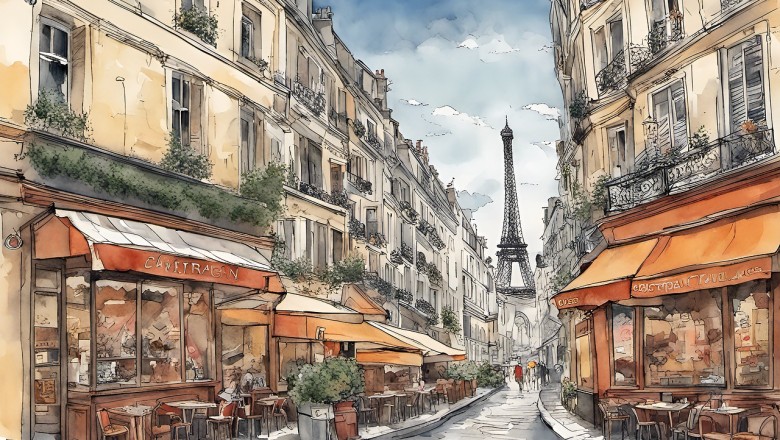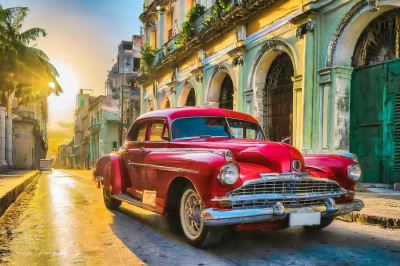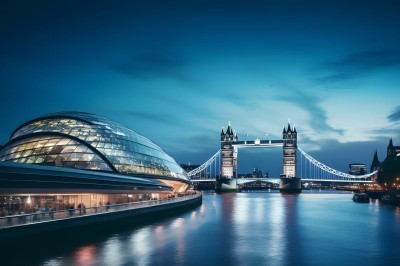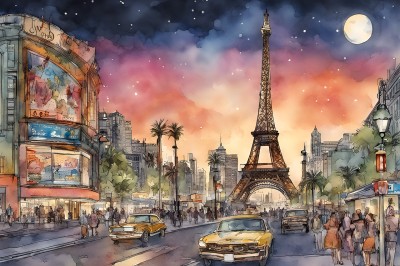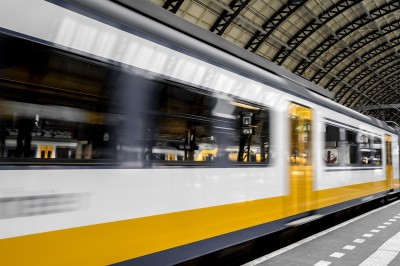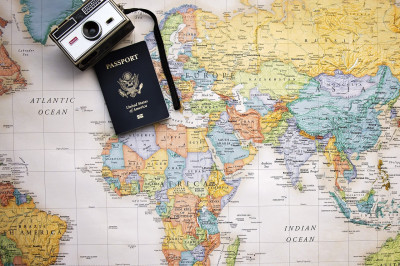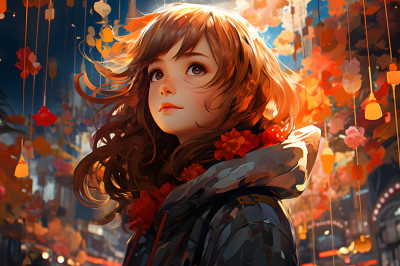Embracing the Parisian Ambiance
Paris, often referred to as the "City of Lights," is a destination that captures the essence of romance, art, and history. The city's ambiance is a tapestry woven with the threads of bustling cafés, majestic architecture, and serene riverbanks, all illuminated by the gentle glow of street lamps and the iconic sparkle of the Eiffel Tower at night.
The Enchantment of Parisian Streets
Strolling through the cobblestone streets of Paris, one is enveloped by an atmosphere of timeless charm. Each quartier (district) offers a distinct flavor, from the bohemian alleys of Montmartre to the chic boulevards of Saint-Germain-des-Prés. The aroma of freshly baked croissants and the sound of clinking glasses resonate through the air, inviting visitors to indulge in the city's culinary delights.
Architectural Marvels and Heritage
Parisian architecture is a feast for the eyes, with landmarks such as Notre-Dame Cathedral, the Arc de Triomphe, and the opulent Palace of Versailles. These historical treasures are not just monuments of the past but living parts of the city's vibrant culture. The Haussmannian buildings that line the grand avenues are as much a part of Paris's identity as the Seine River that meanders through it.
The Cultural Tapestry of Paris
Art and culture are the heartbeats of Paris. The city is home to an unparalleled collection of art in museums like the Louvre and Musée d'Orsay. Beyond the masterpieces hanging on museum walls, art is alive in the street markets, ateliers, and galleries that dot the city, showcasing the work of both renowned artists and emerging talents.
The Rhythm of Parisian Life
Life in Paris moves at its own unique rhythm, a blend of leisure and liveliness. The café culture is a cornerstone of daily life, where locals and tourists alike can be found savoring a café au lait or a glass of wine while watching the world go by. The gardens and parks, such as the Tuileries and Luxembourg Gardens, offer tranquil retreats to relax and enjoy the natural beauty of the city.
The Lure of the Seine
The Seine River is the lifeline of Paris, with its picturesque bridges and riverbanks that have inspired countless artists and lovers throughout the centuries. A cruise along the Seine provides a different perspective of the city's landmarks, while the quaysides transform into social hubs where people gather to picnic, dance, and connect.
Nightfall in Paris
As dusk falls, Paris transforms. The city's nickname, "City of Lights," becomes evident as the monuments are bathed in a golden glow and the streets come alive with the vibrant nightlife. From the cozy jazz clubs of the Latin Quarter to the grand opera houses, Paris by night offers entertainment and experiences that cater to every taste.
Paris is not just a city; it's an experience that engages all the senses. To embrace the Parisian ambiance is to allow oneself to be swept up in the city's rhythm, to find joy in the simple pleasures, and to fall in love with the beauty that unfolds at every corner.
Iconic Landmarks and Monuments: Must-Visit Attractions in ParisEiffel Tower
The Eiffel Tower is the emblem of Paris and a symbol of France around the world. Standing at 324 meters tall, this iron lattice tower was constructed by Gustave Eiffel for the 1889 World's Fair. Visitors can ascend to three levels, with the topmost offering a breathtaking panoramic view of the city. Whether admired during the day or illuminated at night, the Eiffel Tower is a must-see for its historical significance and its role as a beacon of Parisian charm.
Louvre Museum
Originally a royal palace, the Louvre Museum is now the world's largest art museum and a historic monument in Paris. It is home to thousands of works of art, including the Mona Lisa and the Venus de Milo. The museum's iconic glass pyramid entrance, designed by architect I. M. Pei, is a modern contrast to the classic French Renaissance style of the main building.
Notre-Dame Cathedral
Notre-Dame de Paris is a medieval Catholic cathedral on the Île de la Cité. Renowned for its French Gothic architecture, it features a stunning facade, sculpted portals, and the famous flying buttresses. Although it suffered significant damage during a fire in 2019, restoration efforts are underway, and the cathedral remains an essential stop for its historical and architectural value.
Arc de Triomphe
Commissioned by Napoleon after his victory at Austerlitz, the Arc de Triomphe stands at the western end of the Champs-Élysées. It honors those who fought and died for France in the French Revolutionary and Napoleonic Wars. Visitors can climb to the top for a view of the twelve radiating avenues and to see the Tomb of the Unknown Soldier from World War I.
Sacré-Cœur Basilica
Perched atop the Montmartre hill, the Basilica of the Sacred Heart of Paris, or Sacré-Cœur, is known for its white domes and stunning views over Paris. The basilica is a popular spot for both tourists and locals, offering a serene atmosphere away from the bustling city streets. Inside, the mosaic of Christ in Majesty is one of the largest in the world.
Palace of Versailles
Though not within the city limits of Paris, the Palace of Versailles is an essential visit for anyone interested in the grandeur of French royalty. The former royal residence is renowned for its opulent architecture, beautiful gardens, and the Hall of Mirrors. The palace and its grounds are a testament to the lavish lifestyle of the French monarchy before the French Revolution.
Centre Pompidou
The Centre Pompidou, located in the Beaubourg area of the 4th arrondissement, is a cultural hub known for its high-tech architecture. It houses the National Museum of Modern Art, which is the largest museum for modern art in Europe. The building's exterior is characterized by its exposed skeleton of brightly colored tubes and its escalators and pipes running along the outside.
Panthéon
Situated in the Latin Quarter of Paris, the Panthéon was originally built as a church dedicated to St. Genevieve but now functions as a mausoleum containing the remains of distinguished French citizens. The neoclassical building is noted for its dome, which was modeled after the Pantheon in Rome, and its crypt, where visitors can find the tombs of Voltaire, Rousseau, Marie Curie, and other notable figures.
Place de la Concorde
The Place de la Concorde is one of the major public squares in Paris, known for its significant role during the French Revolution. The square features the Luxor Obelisk, a 3,300-year-old Egyptian monument, and two magnificent fountains. It offers a spectacular vista of the Champs-Élysées leading up to the Arc de Triomphe, as well as a view towards the Tuileries Garden and the Louvre Museum.
Les Invalides
The Hôtel National des Invalides, commonly known as Les Invalides, is a complex of buildings containing museums and monuments relating to the military history of France. The most famous part is the Dôme des Invalides, a large church with a golden dome under which Napoleon Bonaparte is buried. The site also includes the Musée de l'Armée, the military museum of the Army of France, and provides a comprehensive overview of French military achievements and history.
Navigating Paris: Transportation Tips for the Savvy TravelerUnderstanding the Paris Metro
The Paris Metro is the heart of public transportation in Paris, with 16 lines and over 300 stations. It's a fast and efficient way to get around the city. Purchase a "carnet" of 10 single-use tickets to save money, or consider a day or multi-day pass if you plan to travel frequently. Each Metro line is identified by its end-of-line destinations and a color code, making it easier to navigate. Remember to keep your ticket until you exit the station, as fare inspectors may ask to see it.
Utilizing the RER Train Network
The RER (Réseau Express Régional) is a regional train network that connects central Paris to its suburbs, including destinations like Disneyland Paris and Charles de Gaulle Airport. There are five RER lines, A through E, which intersect with Metro lines at various stations. RER tickets are priced based on distance traveled, so ensure you have the correct ticket to avoid fines.
Riding Buses and Trams
Paris buses and trams offer scenic routes and are ideal for those who prefer ground-level travel. Bus stops display route maps and schedules, and real-time arrival information is available at many stops. Night buses, known as Noctiliens, operate after the Metro closes. Trams serve the outer arrondissements and suburbs, providing an alternative to the RER for some destinations.
Renting Bikes with Vélib'
Vélib' is Paris's bike-sharing service, with thousands of bikes available across the city. Stations are conveniently located, and you can rent a bike using a credit card at any station kiosk. Rates are affordable, with the first 30 minutes of each ride typically free. Biking is a great way to see the city at your own pace and enjoy the Parisian scenery.
Taking Taxis and Ride-Sharing Services
Taxis can be hailed on the street, found at designated taxi stands, or booked via phone or app. They are metered, and additional charges may apply for luggage or nighttime travel. Ride-sharing services like Uber are also available in Paris and can be a convenient option, especially late at night when public transportation services are limited.
Walking Around Paris
Paris is a walkable city, with many attractions located within close proximity. Walking can often be the quickest way to get around, especially in congested areas where traffic can slow down vehicles. Pedestrian-friendly streets and riverbanks offer a pleasant walking experience. Always have a map or navigation app on hand to help you find your way.
Navigating by River with Batobus
The Batobus is a riverboat shuttle service that operates on the Seine, offering a unique perspective of the city. With stops at key locations like the Eiffel Tower and Notre-Dame, it's both a scenic and practical way to travel. Tickets are available for single rides or as a pass for unlimited travel over a set number of days.
Using the Paris Visite Travel Pass
For tourists, the Paris Visite travel pass provides unlimited travel on the Metro, RER, buses, trams, and the Montmartre funicular. It's available for various zones and valid for 1, 2, 3, or 5 consecutive days. The pass also offers discounts on some attractions and tours, making it a cost-effective option for visitors.
Tips for Efficient Travel
- Avoid rush hours (8-10 am and 5-7 pm) when the Metro and buses are most crowded.
- Always check the last train or bus time to avoid being stranded.
- Use smartphone apps like RATP, Citymapper, or Google Maps for real-time navigation and transport schedules.
- Keep an eye on your belongings, as pickpocketing can occur, especially in crowded areas.
- Learn a few basic French phrases for transportation, such as "un billet" (a ticket) and "Où est la station?" (Where is the station?).
Paris is a culinary capital, boasting an array of dishes that are as sophisticated as they are delicious. At the heart of French cuisine is a respect for ingredients and a dedication to impeccable flavor combinations. Visitors should not miss the chance to try classic dishes such as Coq au Vin, a hearty chicken stew braised with wine, or Boeuf Bourguignon, a rich beef stew that epitomizes French comfort food. For those with a penchant for the sea, Bouillabaisse, a Provençal fish stew, offers a taste of the Mediterranean.
The Art of Patisserie
No guide to Parisian gastronomy would be complete without mentioning the city's legendary patisseries. These temples of sweet delight are where you can indulge in an array of pastries, from the flaky layers of a perfect Croissant to the delicate textures of a Macaron. The Éclair and Tarte au Citron are other must-tries, each a testament to the finesse of French dessert-making.
Cheese and Charcuterie: A Parisian Staple
Cheese and charcuterie are pillars of Parisian food culture. From the pungent Roquefort to the creamy Brie de Meaux, cheese shops in Paris offer an education in flavor. Charcuterie, including saucissons and pâtés, provides a savory counterpoint to the cheeses. A visit to a fromagerie or a charcuterie shop is an opportunity to sample and learn about these artisanal products.
Chic Cafés and Their Role in Parisian Life
Cafés in Paris are more than just places to eat; they are cultural institutions. The café terraces are perfect for people-watching and soaking up the Parisian atmosphere. Iconic spots like Café de Flore and Les Deux Magots are steeped in literary history, having been frequented by famous writers and philosophers. While sipping on a café au lait or enjoying a glass of wine, one can truly feel the pulse of the city.
Wine and Coffee: The Parisian Elixirs
Wine is an integral part of French dining, and Paris offers an extensive selection from all the country's renowned regions. Whether it's a robust Bordeaux, a delicate Burgundy, or a crisp Loire Valley white, there's a wine to complement every meal. Coffee culture is equally important, with a preference for strong espresso-based drinks. Traditional coffee houses serve up expertly brewed beverages alongside modern third-wave coffee shops that emphasize bean origin and brewing technique.
Seasonal and Regional Specialties
Parisian cuisine is deeply connected to the seasons and regions of France. Spring brings fresh asparagus and strawberries, summer is ripe with tomatoes and peaches, autumn offers mushrooms and game, and winter comforts with root vegetables and hearty stews. Regional specialties also make their way into Parisian markets and menus, such as Alsatian tarts, Lyonnaise salads, and Brittany's famous crêpes.
Exploring the Markets
For a true taste of Parisian life, one must explore the local markets. Marché des Enfants Rouges in Le Marais, the city's oldest covered market, is a vibrant spot where fresh produce, flowers, and a variety of food stalls offer a feast for the senses. Other notable markets include Marché Bastille and Marché d'Aligre, each offering a glimpse into the daily culinary habits of Parisians.
Haute Cuisine and Bistronomy
Paris is home to numerous Michelin-starred restaurants where haute cuisine is at its finest. These establishments, often led by celebrity chefs, offer an unforgettable dining experience with innovative dishes and impeccable service. On the other end of the spectrum, the bistronomy movement has seen a rise in casual bistros that serve high-quality, inventive food at more accessible prices. Both scenes contribute to the dynamic and ever-evolving landscape of Parisian gastronomy.
Cultural Riches: Exploring Museums, Galleries, and TheatersMuseums
Paris is a treasure trove of museums, each offering a unique glimpse into the city's and the world's artistic and cultural history. The Louvre, the world's largest art museum, is a must-visit with its iconic glass pyramid and a vast collection that includes the Mona Lisa and the Venus de Milo. For those interested in Impressionist and Post-Impressionist art, the Musée d'Orsay is home to masterpieces by Monet, Van Gogh, and Degas.
The Centre Pompidou stands out with its high-tech architecture and houses the National Museum of Modern Art, which is the largest museum for modern art in Europe. Meanwhile, the Musée de l'Orangerie, located in the beautiful Tuileries Gardens, is famous for Monet's Water Lilies murals.
For those with a taste for the eclectic, the Musée du Quai Branly showcases indigenous art, cultures, and civilizations from Africa, Asia, Oceania, and the Americas. History buffs will appreciate the Musée de l'Armée at Les Invalides, where Napoleon's tomb is located, and the extensive collection of military artifacts.
Galleries
Parisian galleries are as diverse as the city itself, ranging from classical art to contemporary installations. The Marais district is particularly known for its vibrant gallery scene. Galerie Perrotin is a contemporary art gallery that has hosted works by the likes of Takashi Murakami and Jean-Michel Othoniel.
In the Saint-Germain-des-Prés neighborhood, Galerie Kamel Mennour presents a mix of modern and contemporary art, often featuring thought-provoking exhibitions. For those seeking avant-garde and emerging artists, the Belleville neighborhood is burgeoning with small, cutting-edge galleries that challenge traditional art forms.
Theaters
Paris' theater scene is as dynamic as its visual arts, with venues offering everything from classic French drama to international productions. The Opéra Garnier, an architectural masterpiece, is the city's premier opera house, known for its opulent interior and world-class performances. The Comédie-Française, founded in 1680, is one of the oldest running theaters in the world and continues to stage French classics.
For contemporary theater, the Théâtre de la Ville is a hub for innovative productions, dance performances, and international acts. The Théâtre du Châtelet has a diverse program that includes musical theater, opera, and dance, often featuring international companies.
The smaller Théâtre des Bouffes du Nord, with its intimate setting and rustic charm, has been revitalized under the direction of Peter Brook and is known for its avant-garde productions. The Théâtre de l'Odéon, situated in the Latin Quarter, is another historic venue that offers a mix of classic and contemporary theater, reflecting the intellectual and artistic spirit of the area.
Paris' cultural landscape is a testament to the city's enduring love affair with the arts. From the grandeur of its museums to the intimate galleries and vibrant theaters, the city offers an endless array of cultural experiences that continue to enchant and inspire visitors from around the world.
Shopping in Paris: From Haute Couture to Charming Flea MarketsHaute Couture and Luxury Boutiques
Paris is synonymous with fashion, and the city's haute couture scene is a testament to its sartorial legacy. The most prestigious shopping can be found in the Golden Triangle, an area bounded by Avenue Montaigne, the Champs-Élysées, and Avenue George V. Here, luxury boutiques such as Chanel, Dior, and Louis Vuitton showcase their latest collections.
Venture to Rue Saint-Honoré for a continuation of high-end shopping, where stores like Colette (although closed, its spirit lives on) have historically offered a curated selection of cutting-edge fashion. For those seeking bespoke experiences, the ateliers of haute couture designers offer personalized fittings by appointment, ensuring a garment that is uniquely Parisian.
Department Stores and Shopping Arcades
The grandeur of Parisian department stores is not to be missed. Galeries Lafayette and Printemps on Boulevard Haussmann are temples of retail, with their magnificent architecture and dizzying array of goods. From designer labels to affordable brands, cosmetics to homeware, these emporiums provide a one-stop-shop for fashion and lifestyle products.
The city's historic shopping arcades, known as passages couverts, offer a more intimate shopping experience. Galerie Vivienne and Passage Jouffroy, with their mosaic floors and glass roofs, house eclectic boutiques, bookshops, and tea rooms, offering a glimpse into the Paris of yesteryear.
Trendy Boutiques and Concept Stores
The Marais district is a hub for trendy boutiques and avant-garde concept stores. Streets like Rue des Francs-Bourgeois and Rue Vieille du Temple are lined with shops selling the latest in fashion, design, and lifestyle. Concept stores like Merci combine fashion, homeware, and a café space, creating a unique shopping environment.
Le Haut Marais, with its more laid-back vibe, is home to up-and-coming designers and indie boutiques. Here, shoppers can discover unique pieces and limited-edition items that are at the forefront of Parisian cool.
Vintage Shops and Second-Hand Stores
For those with a love for vintage, Paris offers an abundance of second-hand stores and consignment shops. The Latin Quarter and Le Marais are particularly known for their vintage boutiques, where shoppers can find pre-loved designer clothes, retro accessories, and one-of-a-kind items from past decades.
Kilo shops, where goods are sold by weight, are a fun and eco-friendly way to shop for vintage clothing. These stores encourage sustainable fashion and offer a treasure trove of unique finds at reasonable prices.
Charming Flea Markets
No shopping experience in Paris is complete without a visit to its iconic flea markets. The most famous is the Marché aux Puces de Saint-Ouen, located on the outskirts of the city. This sprawling market is a labyrinth of over 2,000 stalls selling antiques, vintage clothing, furniture, and curiosities.
For a more local feel, the Marché aux Puces de la Porte de Vanves offers a smaller but equally charming alternative, with vendors selling everything from old postcards to Art Deco jewelry. Flea markets in Paris are not just places to shop; they are cultural experiences where the past and present merge, and where bargaining is part of the fun.
Green Spaces and Hidden Gems: Finding Serenity in Parisian ParksJardin du Luxembourg
Nestled in the heart of the Left Bank, the Jardin du Luxembourg is a quintessential Parisian experience. This elegant park, inspired by the Boboli Gardens in Florence, was created in 1612 and offers a serene retreat with its lush lawns, tree-lined promenades, and the majestic Luxembourg Palace. Visitors can admire the beautifully landscaped gardens, which feature a collection of statues, fountains, and an iconic central pond where children sail miniature boats.
Parc des Buttes-Chaumont
Escape the hustle and bustle of the city in the Parc des Buttes-Chaumont, located in the 19th arrondissement. Known for its steep hills and dramatic cliffs, the park boasts a variety of landscapes, including a lake, waterfalls, and a temple perched high on a cliff, offering panoramic views of the city. The park's meandering paths and hidden grottoes provide a sense of adventure and tranquility.
Jardin des Plantes
The Jardin des Plantes is not only a green space but also a center for botanical research. This historic garden, founded in 1626, is home to thousands of plant species, arranged in meticulously maintained thematic gardens. Visitors can explore the alpine garden, the rose garden, and the tropical greenhouses. The Jardin des Plantes also houses the National Museum of Natural History, adding an educational twist to your serene stroll.
Parc Monceau
Parc Monceau is a public park situated in the 8th arrondissement, known for its English-style layout. With its curved walkways, statues, and a collection of architectural follies including a picturesque rotunda, an Egyptian pyramid, and Chinese fort, it's a delightful spot for relaxation and cultural exploration. The park's history dates back to the 18th century, making it a fascinating window into Paris's past.
Square du Vert-Galant
For a more intimate green space, visit the Square du Vert-Galant at the western tip of the Île de la Cité. This small park offers a peaceful haven with its willow trees and benches overlooking the Seine. Named after King Henry IV, known as the "Green Gallant," the square is a romantic spot, perfect for watching the boats glide by and enjoying a quiet moment away from the city's commotion.
Promenade Plantée (Coulée Verte René-Dumont)
The Promenade Plantée, also known as the Coulée Verte René-Dumont, is a unique elevated park built on a defunct railway line. Stretching from the Bastille to the Bois de Vincennes, this 4.7-kilometer greenway is lined with a variety of plants, trees, and flowers. It offers a unique perspective of the city and is a favorite among joggers and walkers seeking a green escape above the streets.
Parc de Bagatelle
Located within the Bois de Boulogne, the Parc de Bagatelle is a hidden gem known for its enchanting rose garden, which features thousands of rose bushes from hundreds of species. The park also includes a small neoclassical chateau, peacocks roaming freely, and beautifully designed water features. The tranquil atmosphere of the Parc de Bagatelle makes it an ideal spot for a leisurely afternoon.
Parc de Bercy
Parc de Bercy, situated in the 12th arrondissement, is a modern park that combines the charm of historical heritage with contemporary design. It is divided into three themed gardens: the Romantic Garden, with its fishponds and dappled paths; the Flowerbeds, showcasing seasonal blooms; and the Meadows, an open space for sports and relaxation. The park is adjacent to Bercy Village, a shopping and dining area set in former wine warehouses, providing a perfect blend of nature and urban life.
Jardin des Tuileries
The Jardin des Tuileries is an iconic green space that stretches between the Louvre Museum and Place de la Concorde. Designed by André Le Nôtre, the principal gardener of King Louis XIV, the gardens are a masterpiece of classical French garden design. With its manicured lawns, geometrically arranged trees, and grand fountains, the Tuileries Garden is a popular spot for both tourists and locals. It also hosts temporary art exhibitions, adding a cultural dimension to its natural beauty.
Jardin Anne-Frank
A lesser-known sanctuary in the Marais district is the Jardin Anne-Frank. Opened in 2007, this small garden is dedicated to the memory of Anne Frank and features a sapling from the chestnut tree that Anne admired from her hiding place in Amsterdam. The garden provides a contemplative space with its modern design and a variety of plantings, offering a poignant reminder of history amidst the greenery.
Nightlife and Entertainment: Experiencing Paris After DarkIconic Cabarets and Shows
Paris is renowned for its iconic cabarets, with the Moulin Rouge being the most famous. Offering a mix of dance, music, and often extravagant costumes, a night at a Parisian cabaret is a must-do. The Lido and the Crazy Horse are other notable venues that provide a similar blend of burlesque and variety shows, each with their unique style and history.
Jazz Clubs and Live Music Venues
The city's jazz scene is vibrant and deeply rooted in Parisian culture. Clubs like Duc des Lombards and New Morning host some of the best live jazz performances in the city. For those seeking a broader range of live music, La Bellevilloise and Le Bataclan are popular spots that feature a variety of genres, from rock to electronic.
Chic Cocktail Bars and Speakeasies
Paris's cocktail scene has exploded in recent years, with chic bars serving up innovative concoctions. Le Syndicat and Little Red Door are at the forefront of this movement, offering a sophisticated atmosphere and expertly crafted drinks. Hidden speakeasies like Candelaria and Moonshiner add an element of intrigue to the night, requiring patrons to find their concealed entrances.
Bustling Nightclubs and Dance Floors
For those looking to dance the night away, Paris offers a range of nightclubs. Rex Club and Concrete are well-known for their electronic beats and often feature international DJs. Meanwhile, clubs like Le Baron and Silencio, the latter designed by David Lynch, provide a more exclusive experience with a strict door policy.
Wine Bars and Bistros
Paris wouldn't be Paris without its wine, and the city's wine bars are the perfect place to sample French vintages. Le Baron Rouge and O Chateau are favorites among locals and tourists alike, offering a cozy atmosphere and an extensive selection of wines. Many bistros also stay open late, allowing visitors to enjoy a glass of wine with traditional French cuisine.
Evening River Cruises
The Seine River is the heart of Paris, and an evening cruise offers a unique perspective of the city's illuminated monuments. Companies like Bateaux Parisiens and Vedettes du Pont Neuf provide various options, from simple sightseeing trips to dinner cruises with a full meal and live music.
Outdoor Cinemas and Seasonal Festivals
During the warmer months, Parisians enjoy films under the stars at outdoor cinemas. Parc de la Villette is one such venue that hosts a free open-air film festival. Seasonal festivals also offer a range of nighttime entertainment, from the Fête de la Musique, celebrating music in every corner of the city, to Nuit Blanche, an all-night arts festival.
Theatrical Performances and Opera
The Parisian theater scene is rich and diverse, with venues like Théâtre de la Ville and Odéon-Théâtre de l'Europe presenting classic and contemporary plays. The Opéra Garnier and Opéra Bastille are the go-to places for opera aficionados, showcasing world-class performances in stunning settings.
Late-Night Eateries and Street Food
For those with late-night cravings, Paris offers an array of eateries that remain open into the wee hours. From traditional brasseries to trendy street food vendors, there's something to satisfy every palate. Rue Oberkampf and the Latin Quarter are particularly known for their vibrant late-night food scenes.
Artistic and Cultural Events
Paris is a city that celebrates art and culture at all hours. Many museums, including the Louvre and the Musée d'Orsay, have extended evening hours on certain days, allowing visitors to enjoy their collections in a more intimate setting. Art galleries in the Marais district also host nocturnal events, often coinciding with exhibition openings.



